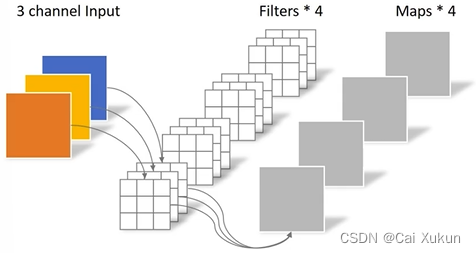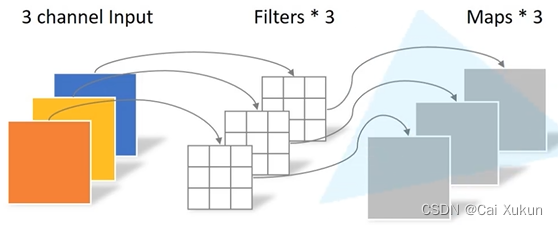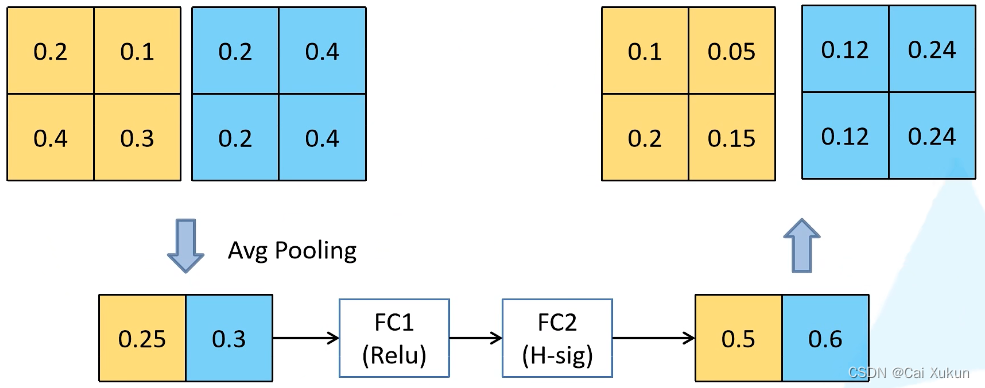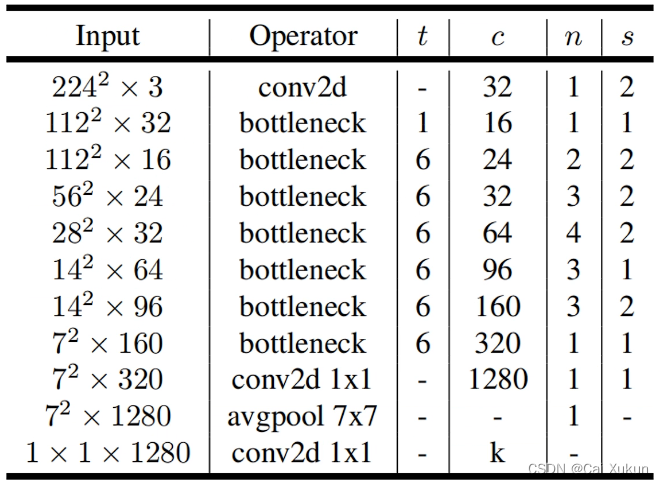目录
1. MobileNet v1网络
在传统的卷积神经网络中,模型参数都比较大,而且对算力的要求很高,很难在移动设备和嵌入式设备上运行,MobileNet实现了将深度学习网络在移动设备和嵌入式设备上运行。
MobileNet网络是Google团队在2017年提出的,是专注于移动端或者嵌入式设备中的轻量级CNN网络。相比传统CNN网络,在准确率小幅度降低的前提下大大减少了模型的参数和运算量。该网络有以下两个亮点:
- Depthwise Convolution(DW卷积,大大减少了参数数量和运算量)
- 增加了控制卷积核个数的超参数
和控制输入图像大小的超参数
在传统的卷积操作中,卷积核的channel数等于输入特征矩阵的channel数,输出特征矩阵的channel数等于所使用卷积核的个数:

而对于DW卷积,卷积核的channel数为1,输入特征矩阵的channel数等于卷积核个数等于输出特征矩阵channel数:

Depthwise Separable Conv由DW卷积和PW卷积组成,PW卷积和传统卷积操作相似,只是卷积核大小均为1×1,理论上传统卷积的计算量是Depthwise Separable Conv操作的8到9倍。
2. MobileNet v2网络
在MobileNet的使用当中,DW卷积的卷积核参数大部分为0,这部分的卷积核没有起到作用,这个问题在MobileNet v2中有所改善,该网络有以下两个亮点:
- Inverted Residual(倒残差结构)
- Linear Bottlenecks
2.1 Inverted Residual
传统的残差结构是先用1×1的卷积核进行降维,然后通过3×3的卷积核进行卷积处理,最后采用1×1的卷积核进行升维,形成了一个两头大中间小的瓶颈结构;而倒残差结构首先利用1×1的卷积核进行升维,然后通过3×3的卷积核进行DW卷积,最后采用1×1的卷积核进行降维处理,和普通的残差结构正好相反。
在普通的残差结构中采用的是ReLU激活函数,而在倒残差结构中采用的则是ReLU6激活函数:
- ReLU激活函数:输入值小于0时默认置0,输入值大于0则不进行操作
- ReLU6激活函数:输入值小于0默认置0,输入值在0~6之间不进行操作,而输入值大于6时则置6,公式为
2.2 Linear Bottlenecks
针对倒残差结构的最后一个卷积层,使用了线性的激活函数而非ReLU激活函数,原文作者进行了实验,内容是ReLU激活函数对低维特征信息会造成大量损失,对高维特征信息造成的损失很小,而倒残差结构是两边细中间粗的结构,输出是一个低维的特征向量,因此使用ReLU激活函数损失会比较大,所以使用线性的激活函数进行替代。
MobileNet v2的block块如下图所示:

要注意只有stride=1且输入特征矩阵与输出特征矩阵的shape相同时才有shortcut连接(即左面那种情况)。
2.3 MobileNet v2模型的网络结构

为扩展因子,即将输入升为多少维;
为输出特征矩阵深度;
为bottleneck的重复次数;
为第一层bottleneck的步长,其余层均为1。
3. MobileNet v3网络
MobileNet v3有以下三个改进点:
- 更新了Block(bneck,在倒残差结构上进行了简单的改动)
- 使用了NAS(Neural Architecture Search)搜索参数的技术
- 重新设计了一些耗时层的结构
对于Block的更新主要有亮点:加入了SE模块,更新了激活函数。结构图如下:

3.1 注意力机制
针对得到的输出矩阵的每个channel进行池化处理,得到一维向量的元素个数等于channel数;经过第一个全连接层,节点个数是channel个数的1/4,激活函数是ReLU;经过第二个全连接层,节点个数等于channel个数,激活函数是hard-sigmoid;最后输出的向量是对矩阵的每个channel分析出了权重关系,重要的channel会分配一个比较大的权重,原理图如下:

3.2 重新设计耗时层结构
减少第一个卷积层的卷积核个数,从32减到16,并且不会影响准确率;精简Last Stage,精简之前的模型如下:

精简之后的模型:

3.3 重新设计激活函数
当时比较常用的激活函数是swish激活函数:
其中
这个激活函数的计算和求导很复杂;对于移动端的设备,为了加速都会进行量化操作,而swish激活函数对于量化操作很复杂。针对这两个问题,提出了h-swish激活函数:
式子中的后半部分是h-sigmoid激活函数。

从图中可以看出,两种激活函数很相似,可以用h-swish替代swish使用,还可以简化量化操作。
3.4 MobileNet v3模型的网络结构

4. 利用Pytorch实现MobileNet
4.1 MobileNet v1、v2
在MobileNet v2网络当中,所有的卷积层基本都是卷积+BN+ReLU6激活函数组成,首先定义这个组合:
class ConvBNReLU(nn.Sequential):
# 输入特征矩阵深度,输出特征矩阵深度,卷积核大小,步长,groups=1是普通卷积、=in_channel是DW卷积
def __init__(self, in_channel, out_channel, kernel_size=3, stride=1, groups=1):
# 填充参数
padding = (kernel_size - 1) // 2
super(ConvBNReLU, self).__init__(
# 首先是卷积操作:输入特征矩阵深度,输出特征矩阵深度,卷积核大小,步长,填充参数,groups为默认值,不需要偏置
nn.Conv2d(in_channel, out_channel, kernel_size, stride, padding, groups=groups, bias=False),
# BN层,输入为卷积操作的输出
nn.BatchNorm2d(out_channel),
# 激活函数
nn.ReLU6(inplace=True)
)倒残差结构:
# 倒残差结构
class InvertedResidual(nn.Module):
# 输入特征矩阵深度,输出特征矩阵深度,步长,深度扩大多少倍
def __init__(self, in_channel, out_channel, stride, expand_ratio):
super(InvertedResidual, self).__init__()
# 第一层卷积层,扩展深度
hidden_channel = in_channel * expand_ratio
# 定义一个布尔变量,步长为1且输入和输出特征矩阵相等时,采用捷径分支
self.use_shortcut = stride == 1 and in_channel == out_channel
# 层列表
layers = []
# t = 1时没有对输入特征矩阵进行扩充,此时不需要第一层卷积层
if expand_ratio != 1:
# 1x1 pointwise conv
layers.append(ConvBNReLU(in_channel, hidden_channel, kernel_size=1))
# extend函数能够一次性批量插入很多元素
layers.extend([
# 3x3 depthwise conv,DW卷积的groups为输入特征矩阵深度
ConvBNReLU(hidden_channel, hidden_channel, stride=stride, groups=hidden_channel),
# 1x1 pointwise conv(linear)
nn.Conv2d(hidden_channel, out_channel, kernel_size=1, bias=False),
# BN层
nn.BatchNorm2d(out_channel),
])
# *的解析见博客http://t.csdn.cn/CnTEA
self.conv = nn.Sequential(*layers)
# 前向传播,判断是否使用捷径分支
def forward(self, x):
if self.use_shortcut:
return x + self.conv(x)
else:
return self.conv(x)定义MobileNet v2的网络结构:
# 网络结构
class MobileNetV2(nn.Module):
# 类别个数和v1网络中的alpha参数
def __init__(self, num_classes=1000, alpha=1.0, round_nearest=8):
super(MobileNetV2, self).__init__()
# 块,注意不是实例化而是赋值
block = InvertedResidual
# 输入特征矩阵深度
input_channel = _make_divisible(32 * alpha, round_nearest)
# 输出通道数
last_channel = _make_divisible(1280 * alpha, round_nearest)
# 对应网络结构的四个参数值
inverted_residual_setting = [
# t, c, n, s
[1, 16, 1, 1],
[6, 24, 2, 2],
[6, 32, 3, 2],
[6, 64, 4, 2],
[6, 96, 3, 1],
[6, 160, 3, 2],
[6, 320, 1, 1],
]
features = []
# 第一个卷积层
features.append(ConvBNReLU(3, input_channel, stride=2))
# building inverted residual residual blockes
for t, c, n, s in inverted_residual_setting:
# 调整每个block输出特征矩阵深度
output_channel = _make_divisible(c * alpha, round_nearest)
# 每个block块的具体结构
for i in range(n):
# s为第一层的步距,其他层均为1
stride = s if i == 0 else 1
features.append(block(input_channel, output_channel, stride, expand_ratio=t))
# 将output_channel传入input_channel,作为下一层的输入
input_channel = output_channel
# 倒数第三个卷积层
features.append(ConvBNReLU(input_channel, last_channel, 1))
# 特征提取层结束
# 将特征提取网络结构传入
self.features = nn.Sequential(*features)
# 分类器
# 平均池化下采样层,输出特征矩阵高和宽为1×1
self.avgpool = nn.AdaptiveAvgPool2d((1, 1))
# Dropout层和全连接层
self.classifier = nn.Sequential(
nn.Dropout(0.2),
nn.Linear(last_channel, num_classes)
)
# 初始化权重
for m in self.modules():
# 遍历每一个子模块
if isinstance(m, nn.Conv2d):
# 如果是卷积层就对权重进行初始化
nn.init.kaiming_normal_(m.weight, mode='fan_out')
# 如果存在偏置则将偏置设置为0
if m.bias is not None:
nn.init.zeros_(m.bias)
elif isinstance(m, nn.BatchNorm2d):
# 如果是BN层将方差设置为1,均值设置为0
nn.init.ones_(m.weight)
nn.init.zeros_(m.bias)
elif isinstance(m, nn.Linear):
# 如果是全连接层,将权重设置为均值为0,方差为0.01的正态分布,偏置设置为0
nn.init.normal_(m.weight, 0, 0.01)
nn.init.zeros_(m.bias)
# 前向传播
def forward(self, x):
x = self.features(x)
x = self.avgpool(x)
# 将输出展平
x = torch.flatten(x, 1)
x = self.classifier(x)
return x4.2 MobileNet v3
对于MobileNet v3网络,多了SE模块:
# 注意力模块
class SqueezeExcitation(nn.Module):
# squeeze_factor:第一个全连接层节点个数是输入的1/4
def __init__(self, input_c: int, squeeze_factor: int = 4):
super(SqueezeExcitation, self).__init__()
squeeze_c = _make_divisible(input_c // squeeze_factor, 8)
# 全连接层
self.fc1 = nn.Conv2d(input_c, squeeze_c, 1)
self.fc2 = nn.Conv2d(squeeze_c, input_c, 1)
def forward(self, x: Tensor):
# 自适应的平均池化操作,将每一个channel上的数据平均池化到1×1的大小
scale = F.adaptive_avg_pool2d(x, output_size=(1, 1))
scale = self.fc1(scale)
scale = F.relu(scale, inplace=True)
scale = self.fc2(scale)
# hardsigmoid激活函数
scale = F.hardsigmoid(scale, inplace=True)
# 直接相乘
return scale * x整个Block块结构:
# 整个Block块结构
class InvertedResidual(nn.Module):
def __init__(self,
cnf: InvertedResidualConfig,
norm_layer: Callable[..., nn.Module]):
super(InvertedResidual, self).__init__()
# 步长只能为1或2
if cnf.stride not in [1, 2]:
raise ValueError("illegal stride value.")
# 判断是否使用捷径分支
self.use_res_connect = (cnf.stride == 1 and cnf.input_c == cnf.out_c)
layers: List[nn.Module] = []
# 判断使用什么激活函数
activation_layer = nn.Hardswish if cnf.use_hs else nn.ReLU
# expand
# 只有第一个bneck没有1×1的升维卷积层
if cnf.expanded_c != cnf.input_c:
layers.append(ConvBNActivation(cnf.input_c,
cnf.expanded_c,
kernel_size=1,
norm_layer=norm_layer,
activation_layer=activation_layer))
# depthwise
layers.append(ConvBNActivation(cnf.expanded_c,
cnf.expanded_c,
kernel_size=cnf.kernel,
stride=cnf.stride,
groups=cnf.expanded_c,
norm_layer=norm_layer,
activation_layer=activation_layer))
if cnf.use_se:
layers.append(SqueezeExcitation(cnf.expanded_c))
# project
layers.append(ConvBNActivation(cnf.expanded_c,
cnf.out_c,
kernel_size=1,
norm_layer=norm_layer,
# 线性激活,没有做任何处理
activation_layer=nn.Identity))
self.block = nn.Sequential(*layers)
self.out_channels = cnf.out_c
self.is_strided = cnf.stride > 1
def forward(self, x: Tensor):
result = self.block(x)
# 是否使用捷径分支
if self.use_res_connect:
result += x
return resultMobileNet v3网络结构:
class MobileNetV3(nn.Module):
# 一系列结构参数列表,倒数第二个全连接层输出节点个数,分类类别个数,InvertedResidual模块
def __init__(self,
inverted_residual_setting: List[InvertedResidualConfig],
last_channel: int,
num_classes: int = 1000,
block: Optional[Callable[..., nn.Module]] = None,
norm_layer: Optional[Callable[..., nn.Module]] = None):
super(MobileNetV3, self).__init__()
# 数据检查
if not inverted_residual_setting:
raise ValueError("The inverted_residual_setting should not be empty.")
elif not (isinstance(inverted_residual_setting, List) and
all([isinstance(s, InvertedResidualConfig) for s in inverted_residual_setting])):
raise TypeError("The inverted_residual_setting should be List[InvertedResidualConfig]")
if block is None:
block = InvertedResidual
if norm_layer is None:
# partial用法http://t.csdn.cn/k80JE
norm_layer = partial(nn.BatchNorm2d, eps=0.001, momentum=0.01)
layers: List[nn.Module] = []
# building first layer
# 获得第一个卷积层输出的channel
firstconv_output_c = inverted_residual_setting[0].input_c
layers.append(ConvBNActivation(3,
firstconv_output_c,
kernel_size=3,
stride=2,
norm_layer=norm_layer,
activation_layer=nn.Hardswish))
# building inverted residual blocks
for cnf in inverted_residual_setting:
layers.append(block(cnf, norm_layer))
# building last several layers
# 获得最后一个bneck结构的输出channel
lastconv_input_c = inverted_residual_setting[-1].out_c
# 160 * 6
lastconv_output_c = 6 * lastconv_input_c
# 最后一个卷积层
layers.append(ConvBNActivation(lastconv_input_c,
lastconv_output_c,
kernel_size=1,
norm_layer=norm_layer,
activation_layer=nn.Hardswish))
self.features = nn.Sequential(*layers)
# 池化层和两个全连接层
self.avgpool = nn.AdaptiveAvgPool2d(1)
self.classifier = nn.Sequential(nn.Linear(lastconv_output_c, last_channel),
nn.Hardswish(inplace=True),
nn.Dropout(p=0.2, inplace=True),
nn.Linear(last_channel, num_classes))
# initial weights
for m in self.modules():
if isinstance(m, nn.Conv2d):
nn.init.kaiming_normal_(m.weight, mode="fan_out")
if m.bias is not None:
nn.init.zeros_(m.bias)
elif isinstance(m, (nn.BatchNorm2d, nn.GroupNorm)):
nn.init.ones_(m.weight)
nn.init.zeros_(m.bias)
elif isinstance(m, nn.Linear):
nn.init.normal_(m.weight, 0, 0.01)
nn.init.zeros_(m.bias)
def _forward_impl(self, x: Tensor):
x = self.features(x)
x = self.avgpool(x)
# 展平处理
x = torch.flatten(x, 1)
x = self.classifier(x)
return x
def forward(self, x: Tensor):
return self._forward_impl(x)5. 训练结果
MobileNet v2采用预训练权重,只训练全连接层的结果:
using cuda:0 device.
Using 4 dataloader workers every process
using 3306 images for training, 364 images for validation.
train epoch[1/5] loss:1.007: 100%|██████████| 207/207 [00:09<00:00, 22.49it/s]
valid epoch[1/5]: 100%|██████████| 23/23 [00:03<00:00, 6.31it/s]
[epoch 1] train_loss: 1.245 val_accuracy: 0.794
train epoch[2/5] loss:0.813: 100%|██████████| 207/207 [00:07<00:00, 27.63it/s]
valid epoch[2/5]: 100%|██████████| 23/23 [00:03<00:00, 6.26it/s]
[epoch 2] train_loss: 0.864 val_accuracy: 0.824
train epoch[3/5] loss:0.580: 100%|██████████| 207/207 [00:07<00:00, 28.38it/s]
valid epoch[3/5]: 100%|██████████| 23/23 [00:03<00:00, 6.28it/s]
[epoch 3] train_loss: 0.716 val_accuracy: 0.865
train epoch[4/5] loss:0.818: 100%|██████████| 207/207 [00:07<00:00, 28.45it/s]
valid epoch[4/5]: 100%|██████████| 23/23 [00:03<00:00, 6.46it/s]
[epoch 4] train_loss: 0.626 val_accuracy: 0.857
train epoch[5/5] loss:0.488: 100%|██████████| 207/207 [00:07<00:00, 28.32it/s]
valid epoch[5/5]: 100%|██████████| 23/23 [00:03<00:00, 6.34it/s]
[epoch 5] train_loss: 0.587 val_accuracy: 0.857
Finished Training
MobileNet v3 large采用预训练权重,只训练全连接层的结果:
using cuda:0 device.
Using 4 dataloader workers every process
using 3306 images for training, 364 images for validation.
train epoch[1/5] loss:0.831: 100%|██████████| 207/207 [00:09<00:00, 22.47it/s]
valid epoch[1/5]: 100%|██████████| 23/23 [00:03<00:00, 6.40it/s]
[epoch 1] train_loss: 0.889 val_accuracy: 0.868
train epoch[2/5] loss:0.824: 100%|██████████| 207/207 [00:07<00:00, 27.67it/s]
valid epoch[2/5]: 100%|██████████| 23/23 [00:03<00:00, 6.50it/s]
[epoch 2] train_loss: 0.508 val_accuracy: 0.887
train epoch[3/5] loss:0.370: 100%|██████████| 207/207 [00:07<00:00, 27.11it/s]
valid epoch[3/5]: 100%|██████████| 23/23 [00:03<00:00, 6.56it/s]
[epoch 3] train_loss: 0.451 val_accuracy: 0.901
train epoch[4/5] loss:0.841: 100%|██████████| 207/207 [00:07<00:00, 27.61it/s]
valid epoch[4/5]: 100%|██████████| 23/23 [00:03<00:00, 6.34it/s]
[epoch 4] train_loss: 0.411 val_accuracy: 0.904
train epoch[5/5] loss:0.195: 100%|██████████| 207/207 [00:07<00:00, 27.60it/s]
valid epoch[5/5]: 100%|██████████| 23/23 [00:03<00:00, 6.32it/s]
[epoch 5] train_loss: 0.378 val_accuracy: 0.904
Finished Training




















 3362
3362











 被折叠的 条评论
为什么被折叠?
被折叠的 条评论
为什么被折叠?








